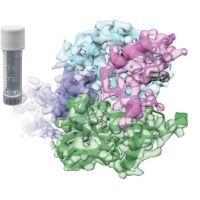Specification
| Organism | Homo sapiens (Human) |
| Expression Host | Baculovirus |
| Tag Info | N-terminal 10xHis-tagged and C-terminal Myc-tagged |
| Purity | Greater than 85% by SDS-PAGE |
| Uniprot ID | Q9BQ69 |
| Gene Names | MACROD1 |
| Alternative Names | MACRO domain-containing protein 1 O-acetyl-ADP-ribose deacetylase MACROD1 Protein LRP16 [Protein ADP-ribosylaspartate] hydrolase MACROD1 [Protein ADP-ribosylglutamate] hydrolase MACROD1 |
| Expression Region | Full Length(1-325aa ) |
| Molecular Weight | 39.4 kDa |
| Protein Sequence | MSLQSRLSGRLAQLRAAGQLLVPPRPRPGHLAGATRTRSSTCGPPAFLGVFGRRARTSAGVGAWGAAAVGRTAGVRTWAPLAMAAKVDLSTSTDWKEAKSFLKGLSDKQREEHYFCKDFVRLKKIPTWKEMAKGVAVKVEEPRYKKDKQLNEKISLLRSDITKLEVDAIVNAANSSLLGGGGVDGCIHRAAGPLLTDECRTLQSCKTGKAKITGGYRLPAKYVIHTVGPIAYGEPSASQAAELRSCYLSSLDLLLEHRLRSVAFPCISTGVFGYPCEAAAEIVLATLREWLEQHKDKVDRLIICVFLEKDEDIYRSRLPHYFPV |
| Form | Liquid or Lyophilization |
| Buffer | The default storage buffer is Tris/PBS-based buffer, 5%-50% glycerol if the delivery form is liquid. The lyophilization buffer is Tris/PBS-based buffer, 6% Trehalose, pH 8.0 if the delivery form is lyophilized powder. Please contact us if you have any special requirment. |
| Reconstitution | Please reconstitute protein in deionized sterile water and we recommend that briefly centrifuge thevial prior to opening the vial .We recommend aliquot for long-term storage at -20℃/-80℃. |
Background
| Relevance | Removes ADP-ribose from asparatate and glutamate residues in proteins bearing a single ADP-ribose moiety (PubMed:23474714, PubMed:23474712). Inactive towards proteins bearing poly-ADP-ribose (PubMed:23474714, PubMed:23474712). Deacetylates O-acetyl-ADP ribose, a signaling molecule generated by the deacetylation of acetylated lysine residues in histones and other proteins (PubMed:21257746). Plays a role in estrogen signaling (PubMed:17893710, PubMed:17914104, PubMed:19403568). Binds to androgen receptor (AR) and amplifies the transactivation function of AR in response to androgen (PubMed:19022849). May play an important role in carcinogenesis and/or progression of hormone-dependent cancers by feed-forward mechanism that activates ESR1 transactivation (PubMed:17893710, PubMed:17914104). Could be an ESR1 coactivator, providing a positive feedback regulatory loop for ESR1 signal transduction (PubMed:17914104). Could be involved in invasive growth by down-regulating CDH1 in endometrial cancer cells (PubMed:17893710). Enhances ESR1-mediated transcription activity (PubMed:17914104). |
| Involvement in Disease | |
| Subcellular Location | |
| Protein Families | |
| Tissue Specificity | MACROD1 |
QC Data
| Note | Please contact us for QC Data |
| Product Image (Reference Only) |  |

